
Egg decorating is the art or craft of decorating eggs. It has been a popular art form throughout history because of the attractive, smooth, oval shape of the egg, and the ancient associations with eggs as a religious and cultural symbol. Egg decorating has been associated with Easter in recent times, but was practiced independently by many ancient cultures.

Nowruz is the Iranian New Year or Persian New Year. Historically, it has been observed by Persians and other Iranian peoples, but is now celebrated by many ethnicities worldwide. It is a festival based on the Northern Hemisphere spring equinox, which marks the first day of a new year on the Solar Hijri calendar; it usually coincides with a date between 19 March and 22 March on the Gregorian calendar.
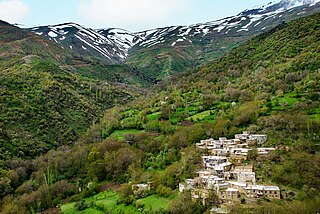
Kurdistan province is one of 31 provinces of Iran. The province is 28,817 km2 in area and its capital is the city of Sanandaj.

Elaeagnus angustifolia, commonly called Russian olive, silver berry, oleaster, or wild olive, is a species of Elaeagnus, native to Asia and limited areas of eastern Europe. It is widely established in North America as an introduced species.

Pussy willow is a name given to many of the smaller species of the genus Salix when their furry catkins are young in early spring. These species include :

Scooby-Doo and the Ghoul School is a 1988 animated comedy horror made-for-television film produced by Hanna-Barbera for syndication as part of the Hanna-Barbera Superstars 10 series.

Azerbaijani dances are traditional dances developed and performed in the Republic of Azerbaijan. These dances are known for their quick tempo and the dancers' traditional clothing.
Iranian wedding, also known as Persian wedding, consists of traditions rooted in Zoroastrianism, the primary religion of pre-Islamic Iran. Though the concepts and theories of marriage have been changed by Islamic traditions, the ceremonies have remained more or less the same as they were originally in pre-Islamic Iran. Although modern-day Iran is a multi-ethnic country, Iranian wedding traditions are embraced by the majority of ethnic groups in Iran.

Sizdah Bedar, also known as Nature's Day, is an Iranian festival held annually on the thirteenth day of Farvardin, the first month of the Iranian calendar (and the first month of spring, during which people spend time picnicking outdoors. It marks the end of the Nowruz holidays in Iran.

Haft Seen or Haft sin is an arrangement of seven symbolic items which names start with the letter "س", the 15th letter in the Persian alphabet; "haft" (هفت) is Persian for "seven". It is traditionally displayed at Nowruz, the Iranian New Year, which is celebrated on the day of the vernal equinox, marking the beginning of spring in the Northern Hemisphere.

Hāji Firuz or Khwāje Piruz is a fictional character in Iranian folklore who appears in the streets by the beginning of Nowruz. His face is covered in soot, and he is clad in bright red clothes and a felt hat. He dances through the streets while singing and playing a tambourine.
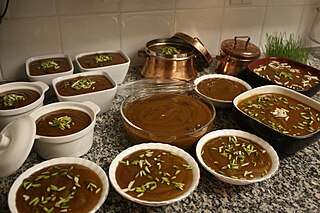
Samanu, Samanak, Sümelek, Sumanak, Sumalak or Sümölök is a sweet paste made from germinated wheat and wheat flour, which is prepared especially for Nowruz in a large pot. This practice has been traced back to the pre-Islamic Sasanian Persian Empire. Although Samanu is prominent for "Haft-Sin", the preparation "mela" and eating it is traditional in Afghanistan.
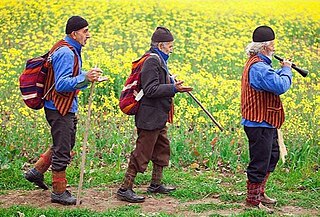
The Tabarian New Year, or Neowrez, occurs in the pintek days of the Tabarian Calendar.
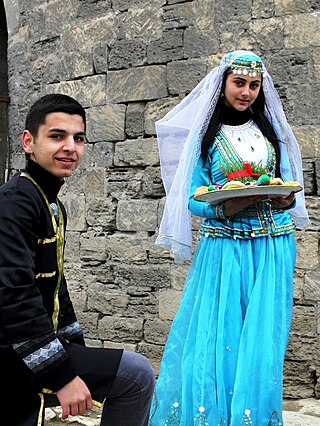
Novruz in Azerbaijan is a traditional holiday which celebrates the astronomical spring equinox and the coming of Spring. When Azerbaijan was part of the Soviet Union, the celebration of Novruz was generally unofficial and at times even prohibited. Currently in Azerbaijan, Novruz is treated as an official public holiday. In accordance with Article 105 of the Labour Code of Azerbaijan passed in 2006, workers receive five days off for Novruz. After neighbouring Iran, Azerbaijan hosts the longest observance and number of public days related to Novruz, with a total of five days.

Amu Nowruz, also known as Baba Nowruz, is a legendary character originating in Iranian folklore. According to the folklore, he appears annually at the beginning of spring, together with his companion Haji Firuz, to mark the beginning of Nowruz, the Iranian New Year. According to some historians he symbolizes Zal, father of Rostam, the hero of Shahnameh.
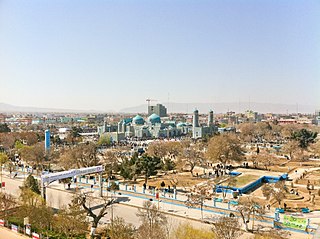
Nowruz is the beginning of springtime and a cultural holiday in Afghanistan. It is also celebrated by the majority of the Afghan diaspora around the world. Farmer's Day, which starts around the same time as the Afghan New Year, is celebrated nationwide alongside Nowruz and usually lasts around two weeks. Among other things, the celebration involves planting saplings and flowers throughout the country.

The Sri Lanka People's Front, commonly known by its Sinhalese name Sri Lanka Podujana Peramuna (SLPP), is a political party in Sri Lanka. It is the current ruling party in Sri Lanka. Previously a minor political party known as the Sri Lanka National Front (SLNF) and Our Sri Lanka Freedom Front (OSLFF), it was relaunched in 2016 as the SLPP and the party became the base for members of the United People's Freedom Alliance loyal to its former leader Mahinda Rajapaksa.
National traditions are well preserved in Azerbaijan. They have a long history, namely originates from the formation of the Azerbaijani people. There are several traditions in Azerbaijan, some customs and traditions differ from region to region.















